HLBN621B: Evidence-Based Nursing Report on Smoking Cessation Plan
VerifiedAdded on 2023/06/14
|12
|3263
|161
Report
AI Summary
This report addresses tobacco smoking as a major public health concern in New Zealand, focusing on its disproportionate impact on vulnerable populations, particularly individuals with schizophrenia. The report centers on a 45-year-old schizophrenic patient, Ms. Veronica Jones, who expresses interest in smoking cessation. It explores the reasons for higher smoking rates among schizophrenics, including socioeconomic factors, personality traits, and neurological correlations. The report then outlines a health education plan tailored to Ms. Jones, emphasizing cultural safety, understanding the ill effects of smoking, and providing support and resources for quitting. The plan includes addressing financial concerns, promoting the benefits of cessation, and managing potential side effects. The report concludes by highlighting the importance of ongoing support and awareness campaigns to facilitate successful smoking cessation among individuals with schizophrenia.

Running head: EVIDENCE BASED NURSING RESEARCH
Summative assessment 1
Name of the Student
Name of the University
Author Note
Summative assessment 1
Name of the Student
Name of the University
Author Note
Paraphrase This Document
Need a fresh take? Get an instant paraphrase of this document with our AI Paraphraser
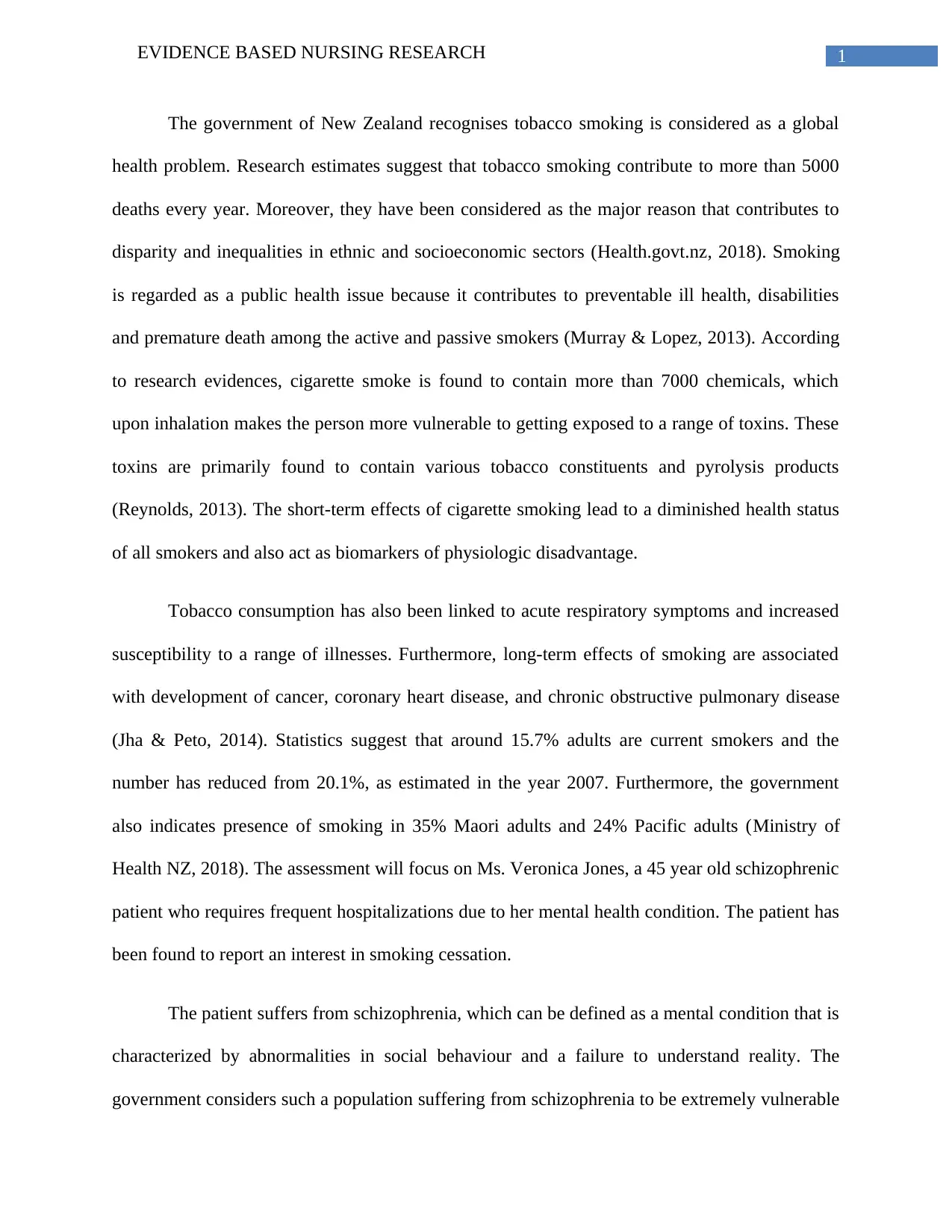
1EVIDENCE BASED NURSING RESEARCH
The government of New Zealand recognises tobacco smoking is considered as a global
health problem. Research estimates suggest that tobacco smoking contribute to more than 5000
deaths every year. Moreover, they have been considered as the major reason that contributes to
disparity and inequalities in ethnic and socioeconomic sectors (Health.govt.nz, 2018). Smoking
is regarded as a public health issue because it contributes to preventable ill health, disabilities
and premature death among the active and passive smokers (Murray & Lopez, 2013). According
to research evidences, cigarette smoke is found to contain more than 7000 chemicals, which
upon inhalation makes the person more vulnerable to getting exposed to a range of toxins. These
toxins are primarily found to contain various tobacco constituents and pyrolysis products
(Reynolds, 2013). The short-term effects of cigarette smoking lead to a diminished health status
of all smokers and also act as biomarkers of physiologic disadvantage.
Tobacco consumption has also been linked to acute respiratory symptoms and increased
susceptibility to a range of illnesses. Furthermore, long-term effects of smoking are associated
with development of cancer, coronary heart disease, and chronic obstructive pulmonary disease
(Jha & Peto, 2014). Statistics suggest that around 15.7% adults are current smokers and the
number has reduced from 20.1%, as estimated in the year 2007. Furthermore, the government
also indicates presence of smoking in 35% Maori adults and 24% Pacific adults (Ministry of
Health NZ, 2018). The assessment will focus on Ms. Veronica Jones, a 45 year old schizophrenic
patient who requires frequent hospitalizations due to her mental health condition. The patient has
been found to report an interest in smoking cessation.
The patient suffers from schizophrenia, which can be defined as a mental condition that is
characterized by abnormalities in social behaviour and a failure to understand reality. The
government considers such a population suffering from schizophrenia to be extremely vulnerable
The government of New Zealand recognises tobacco smoking is considered as a global
health problem. Research estimates suggest that tobacco smoking contribute to more than 5000
deaths every year. Moreover, they have been considered as the major reason that contributes to
disparity and inequalities in ethnic and socioeconomic sectors (Health.govt.nz, 2018). Smoking
is regarded as a public health issue because it contributes to preventable ill health, disabilities
and premature death among the active and passive smokers (Murray & Lopez, 2013). According
to research evidences, cigarette smoke is found to contain more than 7000 chemicals, which
upon inhalation makes the person more vulnerable to getting exposed to a range of toxins. These
toxins are primarily found to contain various tobacco constituents and pyrolysis products
(Reynolds, 2013). The short-term effects of cigarette smoking lead to a diminished health status
of all smokers and also act as biomarkers of physiologic disadvantage.
Tobacco consumption has also been linked to acute respiratory symptoms and increased
susceptibility to a range of illnesses. Furthermore, long-term effects of smoking are associated
with development of cancer, coronary heart disease, and chronic obstructive pulmonary disease
(Jha & Peto, 2014). Statistics suggest that around 15.7% adults are current smokers and the
number has reduced from 20.1%, as estimated in the year 2007. Furthermore, the government
also indicates presence of smoking in 35% Maori adults and 24% Pacific adults (Ministry of
Health NZ, 2018). The assessment will focus on Ms. Veronica Jones, a 45 year old schizophrenic
patient who requires frequent hospitalizations due to her mental health condition. The patient has
been found to report an interest in smoking cessation.
The patient suffers from schizophrenia, which can be defined as a mental condition that is
characterized by abnormalities in social behaviour and a failure to understand reality. The
government considers such a population suffering from schizophrenia to be extremely vulnerable
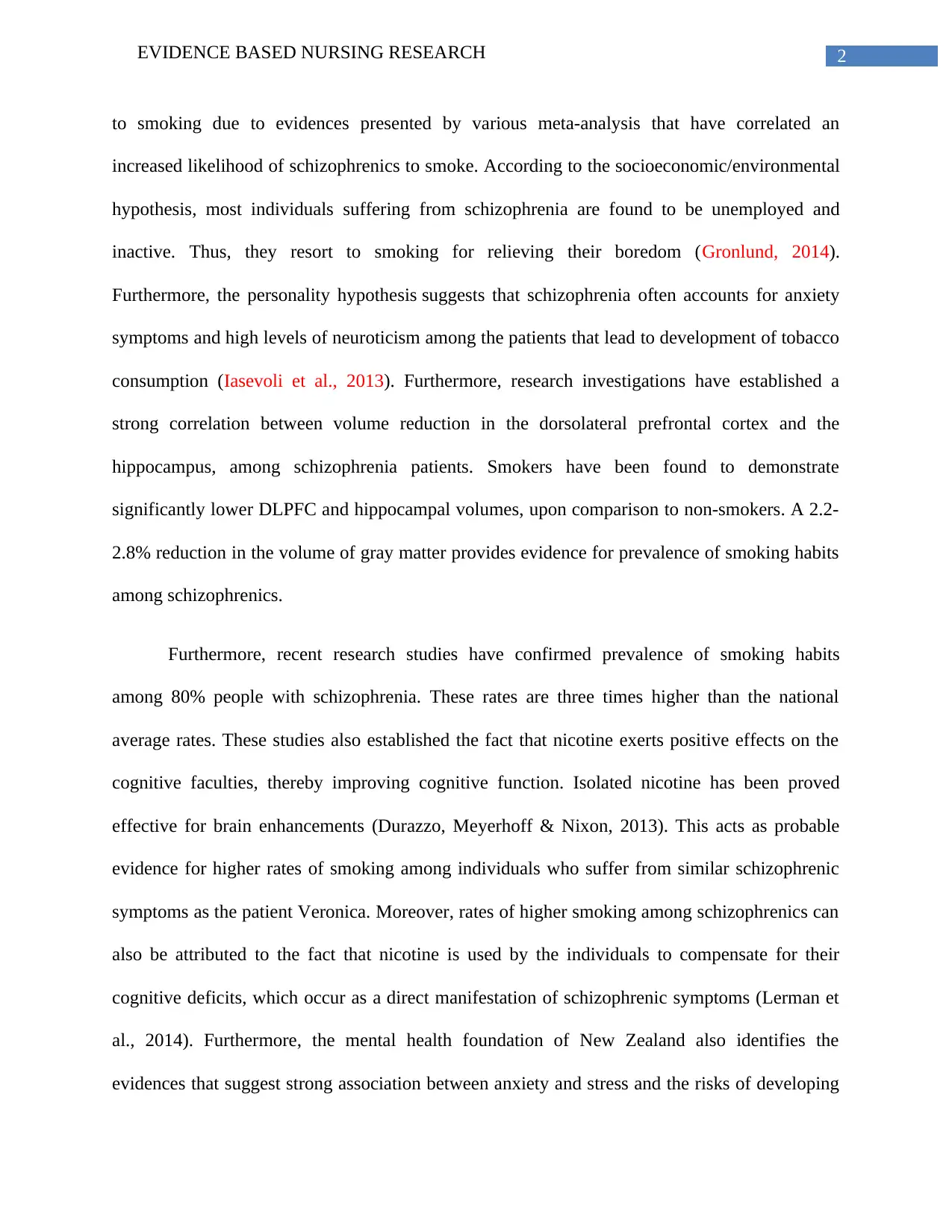
2EVIDENCE BASED NURSING RESEARCH
to smoking due to evidences presented by various meta-analysis that have correlated an
increased likelihood of schizophrenics to smoke. According to the socioeconomic/environmental
hypothesis, most individuals suffering from schizophrenia are found to be unemployed and
inactive. Thus, they resort to smoking for relieving their boredom (Gronlund, 2014).
Furthermore, the personality hypothesis suggests that schizophrenia often accounts for anxiety
symptoms and high levels of neuroticism among the patients that lead to development of tobacco
consumption (Iasevoli et al., 2013). Furthermore, research investigations have established a
strong correlation between volume reduction in the dorsolateral prefrontal cortex and the
hippocampus, among schizophrenia patients. Smokers have been found to demonstrate
significantly lower DLPFC and hippocampal volumes, upon comparison to non-smokers. A 2.2-
2.8% reduction in the volume of gray matter provides evidence for prevalence of smoking habits
among schizophrenics.
Furthermore, recent research studies have confirmed prevalence of smoking habits
among 80% people with schizophrenia. These rates are three times higher than the national
average rates. These studies also established the fact that nicotine exerts positive effects on the
cognitive faculties, thereby improving cognitive function. Isolated nicotine has been proved
effective for brain enhancements (Durazzo, Meyerhoff & Nixon, 2013). This acts as probable
evidence for higher rates of smoking among individuals who suffer from similar schizophrenic
symptoms as the patient Veronica. Moreover, rates of higher smoking among schizophrenics can
also be attributed to the fact that nicotine is used by the individuals to compensate for their
cognitive deficits, which occur as a direct manifestation of schizophrenic symptoms (Lerman et
al., 2014). Furthermore, the mental health foundation of New Zealand also identifies the
evidences that suggest strong association between anxiety and stress and the risks of developing
to smoking due to evidences presented by various meta-analysis that have correlated an
increased likelihood of schizophrenics to smoke. According to the socioeconomic/environmental
hypothesis, most individuals suffering from schizophrenia are found to be unemployed and
inactive. Thus, they resort to smoking for relieving their boredom (Gronlund, 2014).
Furthermore, the personality hypothesis suggests that schizophrenia often accounts for anxiety
symptoms and high levels of neuroticism among the patients that lead to development of tobacco
consumption (Iasevoli et al., 2013). Furthermore, research investigations have established a
strong correlation between volume reduction in the dorsolateral prefrontal cortex and the
hippocampus, among schizophrenia patients. Smokers have been found to demonstrate
significantly lower DLPFC and hippocampal volumes, upon comparison to non-smokers. A 2.2-
2.8% reduction in the volume of gray matter provides evidence for prevalence of smoking habits
among schizophrenics.
Furthermore, recent research studies have confirmed prevalence of smoking habits
among 80% people with schizophrenia. These rates are three times higher than the national
average rates. These studies also established the fact that nicotine exerts positive effects on the
cognitive faculties, thereby improving cognitive function. Isolated nicotine has been proved
effective for brain enhancements (Durazzo, Meyerhoff & Nixon, 2013). This acts as probable
evidence for higher rates of smoking among individuals who suffer from similar schizophrenic
symptoms as the patient Veronica. Moreover, rates of higher smoking among schizophrenics can
also be attributed to the fact that nicotine is used by the individuals to compensate for their
cognitive deficits, which occur as a direct manifestation of schizophrenic symptoms (Lerman et
al., 2014). Furthermore, the mental health foundation of New Zealand also identifies the
evidences that suggest strong association between anxiety and stress and the risks of developing
⊘ This is a preview!⊘
Do you want full access?
Subscribe today to unlock all pages.

Trusted by 1+ million students worldwide
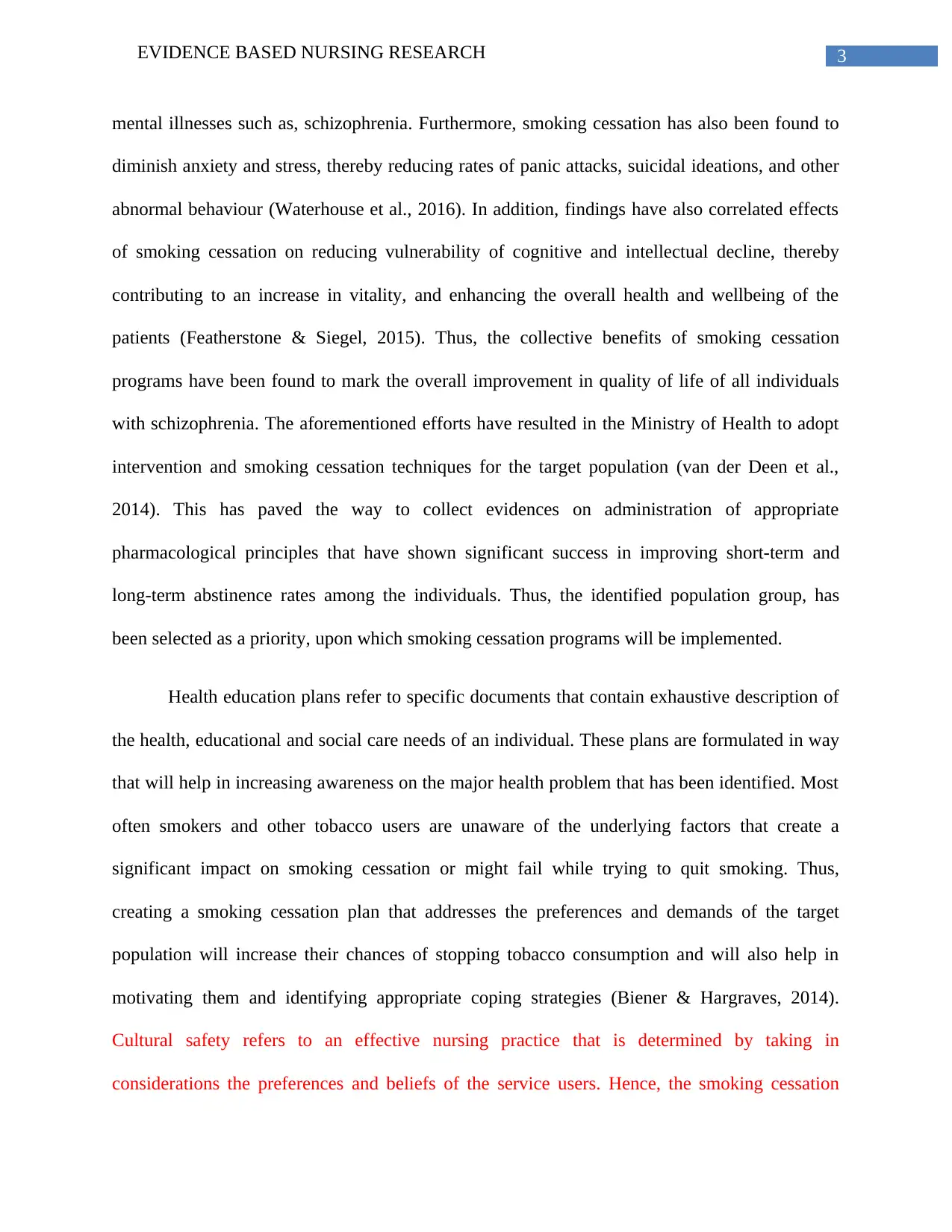
3EVIDENCE BASED NURSING RESEARCH
mental illnesses such as, schizophrenia. Furthermore, smoking cessation has also been found to
diminish anxiety and stress, thereby reducing rates of panic attacks, suicidal ideations, and other
abnormal behaviour (Waterhouse et al., 2016). In addition, findings have also correlated effects
of smoking cessation on reducing vulnerability of cognitive and intellectual decline, thereby
contributing to an increase in vitality, and enhancing the overall health and wellbeing of the
patients (Featherstone & Siegel, 2015). Thus, the collective benefits of smoking cessation
programs have been found to mark the overall improvement in quality of life of all individuals
with schizophrenia. The aforementioned efforts have resulted in the Ministry of Health to adopt
intervention and smoking cessation techniques for the target population (van der Deen et al.,
2014). This has paved the way to collect evidences on administration of appropriate
pharmacological principles that have shown significant success in improving short-term and
long-term abstinence rates among the individuals. Thus, the identified population group, has
been selected as a priority, upon which smoking cessation programs will be implemented.
Health education plans refer to specific documents that contain exhaustive description of
the health, educational and social care needs of an individual. These plans are formulated in way
that will help in increasing awareness on the major health problem that has been identified. Most
often smokers and other tobacco users are unaware of the underlying factors that create a
significant impact on smoking cessation or might fail while trying to quit smoking. Thus,
creating a smoking cessation plan that addresses the preferences and demands of the target
population will increase their chances of stopping tobacco consumption and will also help in
motivating them and identifying appropriate coping strategies (Biener & Hargraves, 2014).
Cultural safety refers to an effective nursing practice that is determined by taking in
considerations the preferences and beliefs of the service users. Hence, the smoking cessation
mental illnesses such as, schizophrenia. Furthermore, smoking cessation has also been found to
diminish anxiety and stress, thereby reducing rates of panic attacks, suicidal ideations, and other
abnormal behaviour (Waterhouse et al., 2016). In addition, findings have also correlated effects
of smoking cessation on reducing vulnerability of cognitive and intellectual decline, thereby
contributing to an increase in vitality, and enhancing the overall health and wellbeing of the
patients (Featherstone & Siegel, 2015). Thus, the collective benefits of smoking cessation
programs have been found to mark the overall improvement in quality of life of all individuals
with schizophrenia. The aforementioned efforts have resulted in the Ministry of Health to adopt
intervention and smoking cessation techniques for the target population (van der Deen et al.,
2014). This has paved the way to collect evidences on administration of appropriate
pharmacological principles that have shown significant success in improving short-term and
long-term abstinence rates among the individuals. Thus, the identified population group, has
been selected as a priority, upon which smoking cessation programs will be implemented.
Health education plans refer to specific documents that contain exhaustive description of
the health, educational and social care needs of an individual. These plans are formulated in way
that will help in increasing awareness on the major health problem that has been identified. Most
often smokers and other tobacco users are unaware of the underlying factors that create a
significant impact on smoking cessation or might fail while trying to quit smoking. Thus,
creating a smoking cessation plan that addresses the preferences and demands of the target
population will increase their chances of stopping tobacco consumption and will also help in
motivating them and identifying appropriate coping strategies (Biener & Hargraves, 2014).
Cultural safety refers to an effective nursing practice that is determined by taking in
considerations the preferences and beliefs of the service users. Hence, the smoking cessation
Paraphrase This Document
Need a fresh take? Get an instant paraphrase of this document with our AI Paraphraser
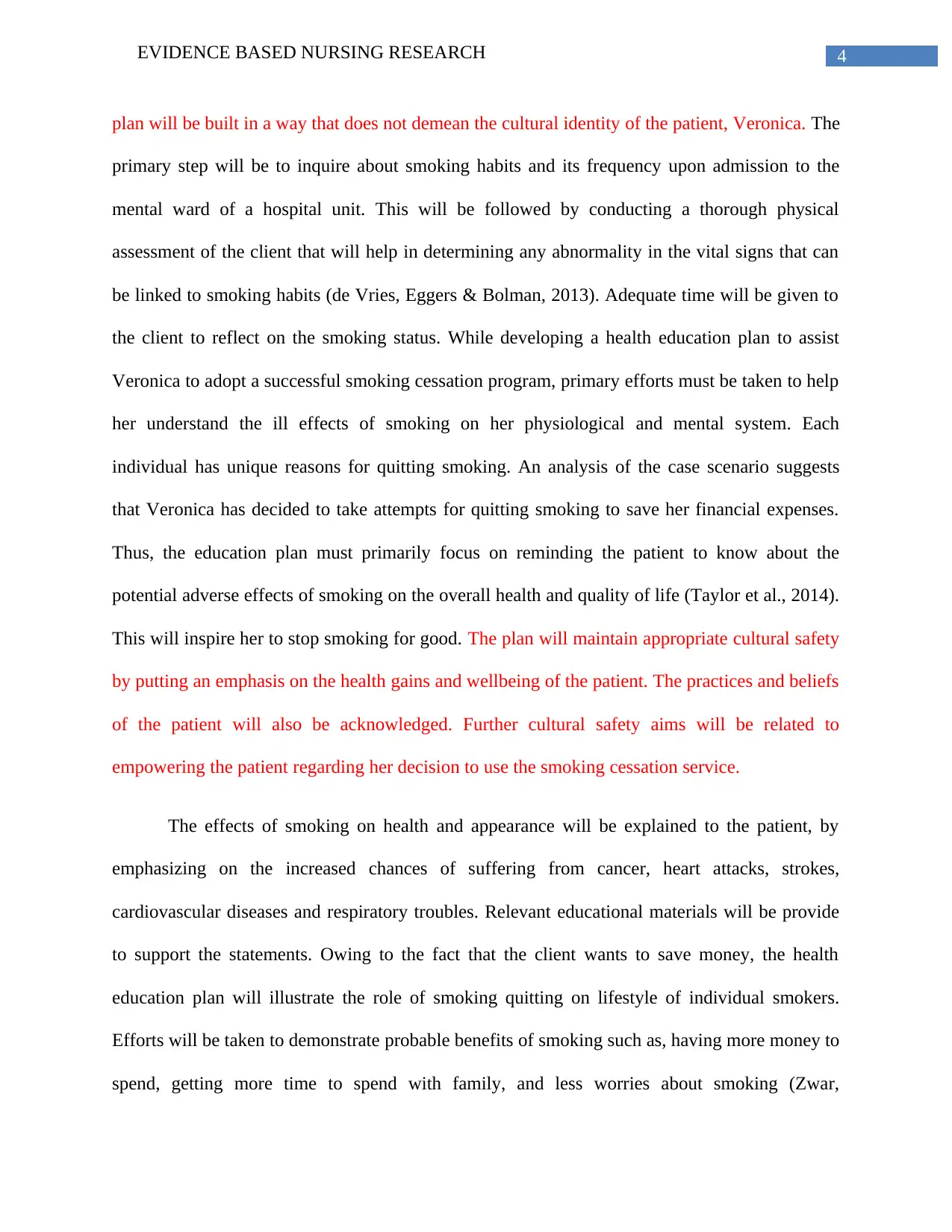
4EVIDENCE BASED NURSING RESEARCH
plan will be built in a way that does not demean the cultural identity of the patient, Veronica. The
primary step will be to inquire about smoking habits and its frequency upon admission to the
mental ward of a hospital unit. This will be followed by conducting a thorough physical
assessment of the client that will help in determining any abnormality in the vital signs that can
be linked to smoking habits (de Vries, Eggers & Bolman, 2013). Adequate time will be given to
the client to reflect on the smoking status. While developing a health education plan to assist
Veronica to adopt a successful smoking cessation program, primary efforts must be taken to help
her understand the ill effects of smoking on her physiological and mental system. Each
individual has unique reasons for quitting smoking. An analysis of the case scenario suggests
that Veronica has decided to take attempts for quitting smoking to save her financial expenses.
Thus, the education plan must primarily focus on reminding the patient to know about the
potential adverse effects of smoking on the overall health and quality of life (Taylor et al., 2014).
This will inspire her to stop smoking for good. The plan will maintain appropriate cultural safety
by putting an emphasis on the health gains and wellbeing of the patient. The practices and beliefs
of the patient will also be acknowledged. Further cultural safety aims will be related to
empowering the patient regarding her decision to use the smoking cessation service.
The effects of smoking on health and appearance will be explained to the patient, by
emphasizing on the increased chances of suffering from cancer, heart attacks, strokes,
cardiovascular diseases and respiratory troubles. Relevant educational materials will be provide
to support the statements. Owing to the fact that the client wants to save money, the health
education plan will illustrate the role of smoking quitting on lifestyle of individual smokers.
Efforts will be taken to demonstrate probable benefits of smoking such as, having more money to
spend, getting more time to spend with family, and less worries about smoking (Zwar,
plan will be built in a way that does not demean the cultural identity of the patient, Veronica. The
primary step will be to inquire about smoking habits and its frequency upon admission to the
mental ward of a hospital unit. This will be followed by conducting a thorough physical
assessment of the client that will help in determining any abnormality in the vital signs that can
be linked to smoking habits (de Vries, Eggers & Bolman, 2013). Adequate time will be given to
the client to reflect on the smoking status. While developing a health education plan to assist
Veronica to adopt a successful smoking cessation program, primary efforts must be taken to help
her understand the ill effects of smoking on her physiological and mental system. Each
individual has unique reasons for quitting smoking. An analysis of the case scenario suggests
that Veronica has decided to take attempts for quitting smoking to save her financial expenses.
Thus, the education plan must primarily focus on reminding the patient to know about the
potential adverse effects of smoking on the overall health and quality of life (Taylor et al., 2014).
This will inspire her to stop smoking for good. The plan will maintain appropriate cultural safety
by putting an emphasis on the health gains and wellbeing of the patient. The practices and beliefs
of the patient will also be acknowledged. Further cultural safety aims will be related to
empowering the patient regarding her decision to use the smoking cessation service.
The effects of smoking on health and appearance will be explained to the patient, by
emphasizing on the increased chances of suffering from cancer, heart attacks, strokes,
cardiovascular diseases and respiratory troubles. Relevant educational materials will be provide
to support the statements. Owing to the fact that the client wants to save money, the health
education plan will illustrate the role of smoking quitting on lifestyle of individual smokers.
Efforts will be taken to demonstrate probable benefits of smoking such as, having more money to
spend, getting more time to spend with family, and less worries about smoking (Zwar,
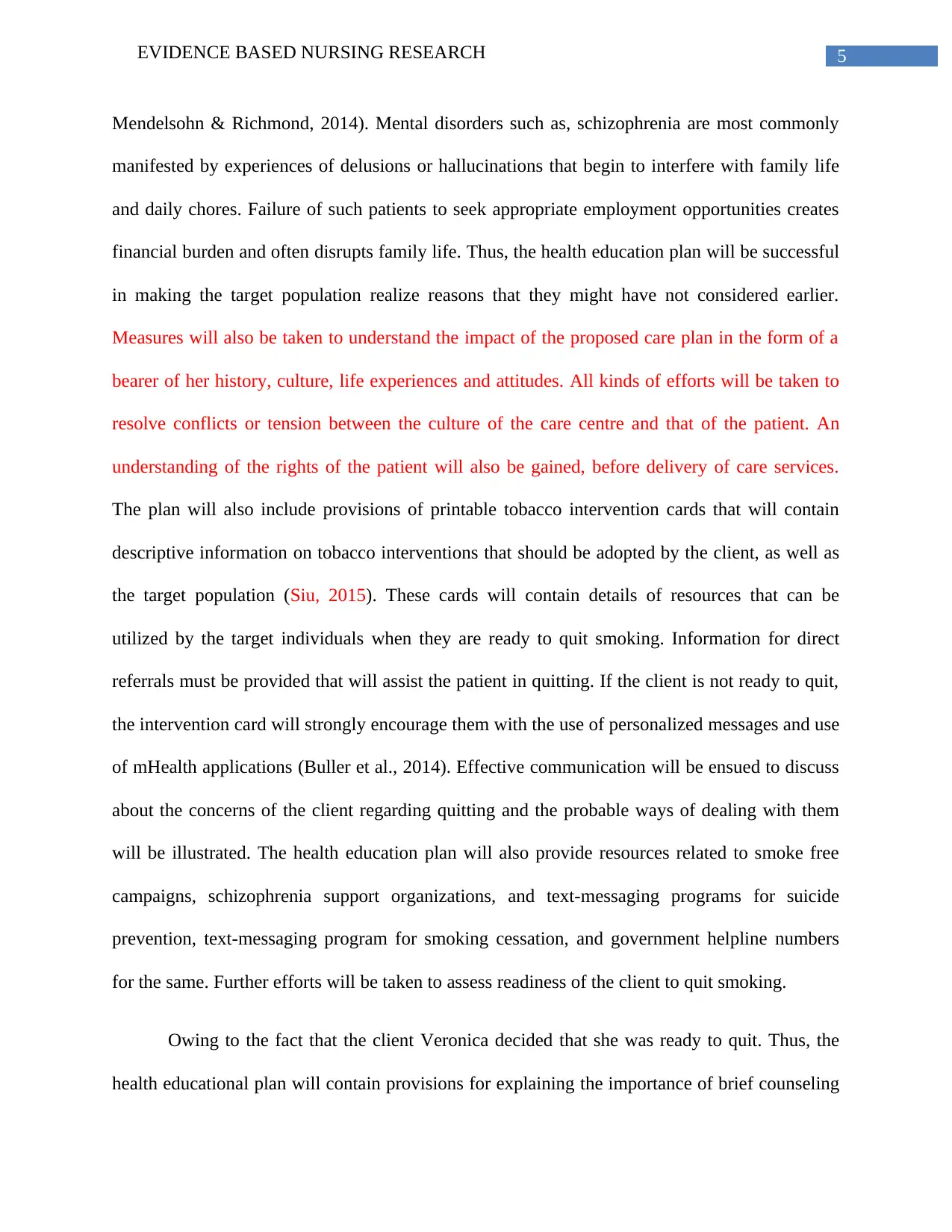
5EVIDENCE BASED NURSING RESEARCH
Mendelsohn & Richmond, 2014). Mental disorders such as, schizophrenia are most commonly
manifested by experiences of delusions or hallucinations that begin to interfere with family life
and daily chores. Failure of such patients to seek appropriate employment opportunities creates
financial burden and often disrupts family life. Thus, the health education plan will be successful
in making the target population realize reasons that they might have not considered earlier.
Measures will also be taken to understand the impact of the proposed care plan in the form of a
bearer of her history, culture, life experiences and attitudes. All kinds of efforts will be taken to
resolve conflicts or tension between the culture of the care centre and that of the patient. An
understanding of the rights of the patient will also be gained, before delivery of care services.
The plan will also include provisions of printable tobacco intervention cards that will contain
descriptive information on tobacco interventions that should be adopted by the client, as well as
the target population (Siu, 2015). These cards will contain details of resources that can be
utilized by the target individuals when they are ready to quit smoking. Information for direct
referrals must be provided that will assist the patient in quitting. If the client is not ready to quit,
the intervention card will strongly encourage them with the use of personalized messages and use
of mHealth applications (Buller et al., 2014). Effective communication will be ensued to discuss
about the concerns of the client regarding quitting and the probable ways of dealing with them
will be illustrated. The health education plan will also provide resources related to smoke free
campaigns, schizophrenia support organizations, and text-messaging programs for suicide
prevention, text-messaging program for smoking cessation, and government helpline numbers
for the same. Further efforts will be taken to assess readiness of the client to quit smoking.
Owing to the fact that the client Veronica decided that she was ready to quit. Thus, the
health educational plan will contain provisions for explaining the importance of brief counseling
Mendelsohn & Richmond, 2014). Mental disorders such as, schizophrenia are most commonly
manifested by experiences of delusions or hallucinations that begin to interfere with family life
and daily chores. Failure of such patients to seek appropriate employment opportunities creates
financial burden and often disrupts family life. Thus, the health education plan will be successful
in making the target population realize reasons that they might have not considered earlier.
Measures will also be taken to understand the impact of the proposed care plan in the form of a
bearer of her history, culture, life experiences and attitudes. All kinds of efforts will be taken to
resolve conflicts or tension between the culture of the care centre and that of the patient. An
understanding of the rights of the patient will also be gained, before delivery of care services.
The plan will also include provisions of printable tobacco intervention cards that will contain
descriptive information on tobacco interventions that should be adopted by the client, as well as
the target population (Siu, 2015). These cards will contain details of resources that can be
utilized by the target individuals when they are ready to quit smoking. Information for direct
referrals must be provided that will assist the patient in quitting. If the client is not ready to quit,
the intervention card will strongly encourage them with the use of personalized messages and use
of mHealth applications (Buller et al., 2014). Effective communication will be ensued to discuss
about the concerns of the client regarding quitting and the probable ways of dealing with them
will be illustrated. The health education plan will also provide resources related to smoke free
campaigns, schizophrenia support organizations, and text-messaging programs for suicide
prevention, text-messaging program for smoking cessation, and government helpline numbers
for the same. Further efforts will be taken to assess readiness of the client to quit smoking.
Owing to the fact that the client Veronica decided that she was ready to quit. Thus, the
health educational plan will contain provisions for explaining the importance of brief counseling
⊘ This is a preview!⊘
Do you want full access?
Subscribe today to unlock all pages.

Trusted by 1+ million students worldwide
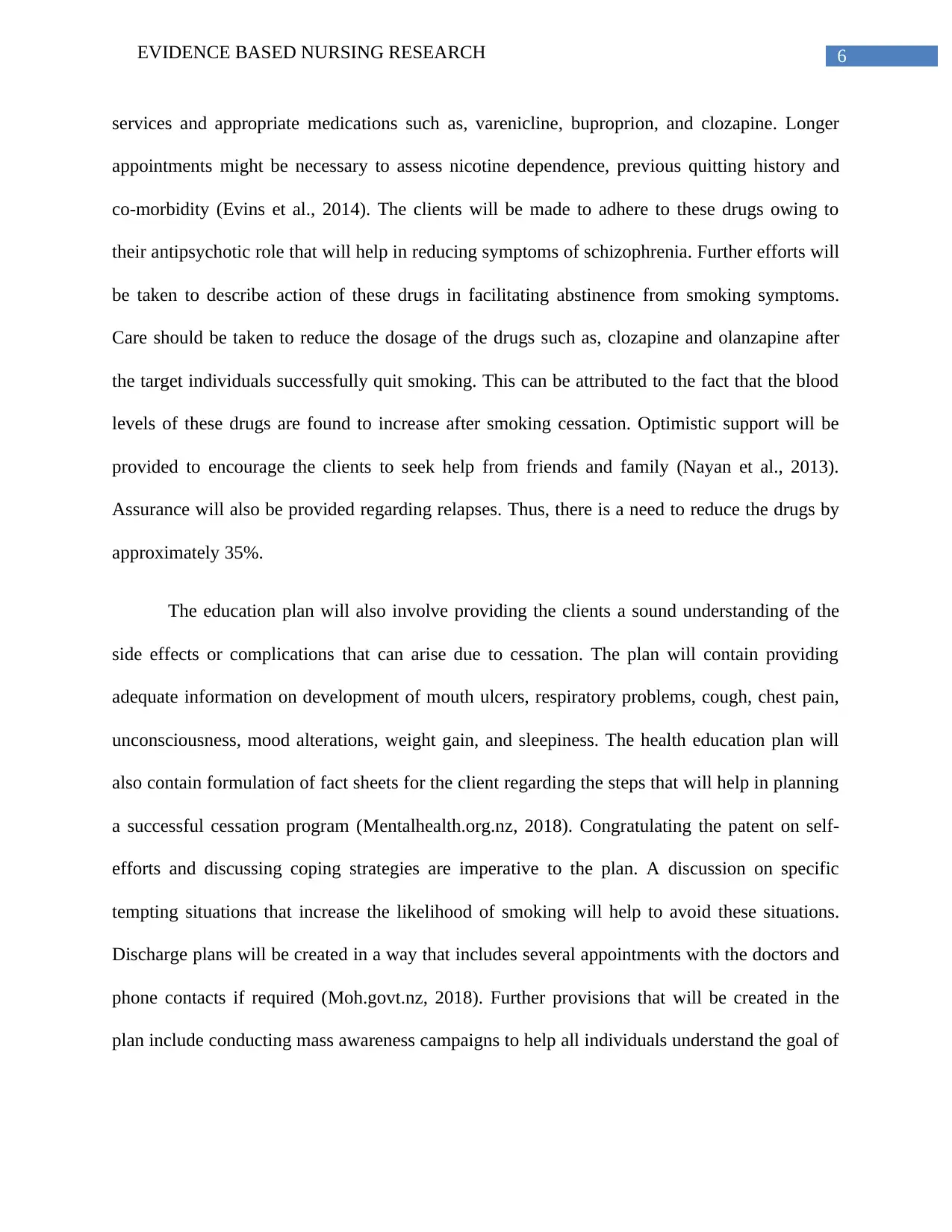
6EVIDENCE BASED NURSING RESEARCH
services and appropriate medications such as, varenicline, buproprion, and clozapine. Longer
appointments might be necessary to assess nicotine dependence, previous quitting history and
co-morbidity (Evins et al., 2014). The clients will be made to adhere to these drugs owing to
their antipsychotic role that will help in reducing symptoms of schizophrenia. Further efforts will
be taken to describe action of these drugs in facilitating abstinence from smoking symptoms.
Care should be taken to reduce the dosage of the drugs such as, clozapine and olanzapine after
the target individuals successfully quit smoking. This can be attributed to the fact that the blood
levels of these drugs are found to increase after smoking cessation. Optimistic support will be
provided to encourage the clients to seek help from friends and family (Nayan et al., 2013).
Assurance will also be provided regarding relapses. Thus, there is a need to reduce the drugs by
approximately 35%.
The education plan will also involve providing the clients a sound understanding of the
side effects or complications that can arise due to cessation. The plan will contain providing
adequate information on development of mouth ulcers, respiratory problems, cough, chest pain,
unconsciousness, mood alterations, weight gain, and sleepiness. The health education plan will
also contain formulation of fact sheets for the client regarding the steps that will help in planning
a successful cessation program (Mentalhealth.org.nz, 2018). Congratulating the patent on self-
efforts and discussing coping strategies are imperative to the plan. A discussion on specific
tempting situations that increase the likelihood of smoking will help to avoid these situations.
Discharge plans will be created in a way that includes several appointments with the doctors and
phone contacts if required (Moh.govt.nz, 2018). Further provisions that will be created in the
plan include conducting mass awareness campaigns to help all individuals understand the goal of
services and appropriate medications such as, varenicline, buproprion, and clozapine. Longer
appointments might be necessary to assess nicotine dependence, previous quitting history and
co-morbidity (Evins et al., 2014). The clients will be made to adhere to these drugs owing to
their antipsychotic role that will help in reducing symptoms of schizophrenia. Further efforts will
be taken to describe action of these drugs in facilitating abstinence from smoking symptoms.
Care should be taken to reduce the dosage of the drugs such as, clozapine and olanzapine after
the target individuals successfully quit smoking. This can be attributed to the fact that the blood
levels of these drugs are found to increase after smoking cessation. Optimistic support will be
provided to encourage the clients to seek help from friends and family (Nayan et al., 2013).
Assurance will also be provided regarding relapses. Thus, there is a need to reduce the drugs by
approximately 35%.
The education plan will also involve providing the clients a sound understanding of the
side effects or complications that can arise due to cessation. The plan will contain providing
adequate information on development of mouth ulcers, respiratory problems, cough, chest pain,
unconsciousness, mood alterations, weight gain, and sleepiness. The health education plan will
also contain formulation of fact sheets for the client regarding the steps that will help in planning
a successful cessation program (Mentalhealth.org.nz, 2018). Congratulating the patent on self-
efforts and discussing coping strategies are imperative to the plan. A discussion on specific
tempting situations that increase the likelihood of smoking will help to avoid these situations.
Discharge plans will be created in a way that includes several appointments with the doctors and
phone contacts if required (Moh.govt.nz, 2018). Further provisions that will be created in the
plan include conducting mass awareness campaigns to help all individuals understand the goal of
Paraphrase This Document
Need a fresh take? Get an instant paraphrase of this document with our AI Paraphraser
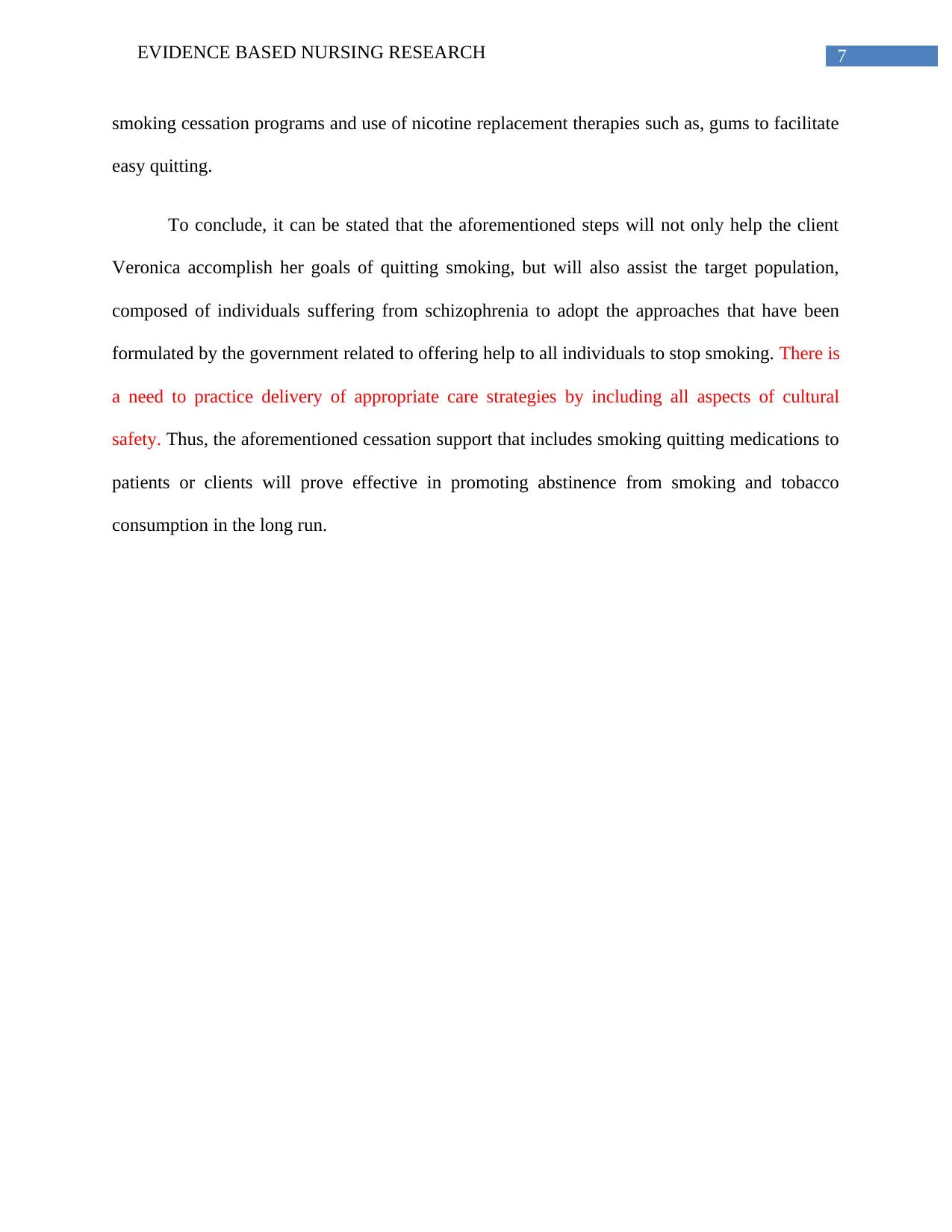
7EVIDENCE BASED NURSING RESEARCH
smoking cessation programs and use of nicotine replacement therapies such as, gums to facilitate
easy quitting.
To conclude, it can be stated that the aforementioned steps will not only help the client
Veronica accomplish her goals of quitting smoking, but will also assist the target population,
composed of individuals suffering from schizophrenia to adopt the approaches that have been
formulated by the government related to offering help to all individuals to stop smoking. There is
a need to practice delivery of appropriate care strategies by including all aspects of cultural
safety. Thus, the aforementioned cessation support that includes smoking quitting medications to
patients or clients will prove effective in promoting abstinence from smoking and tobacco
consumption in the long run.
smoking cessation programs and use of nicotine replacement therapies such as, gums to facilitate
easy quitting.
To conclude, it can be stated that the aforementioned steps will not only help the client
Veronica accomplish her goals of quitting smoking, but will also assist the target population,
composed of individuals suffering from schizophrenia to adopt the approaches that have been
formulated by the government related to offering help to all individuals to stop smoking. There is
a need to practice delivery of appropriate care strategies by including all aspects of cultural
safety. Thus, the aforementioned cessation support that includes smoking quitting medications to
patients or clients will prove effective in promoting abstinence from smoking and tobacco
consumption in the long run.
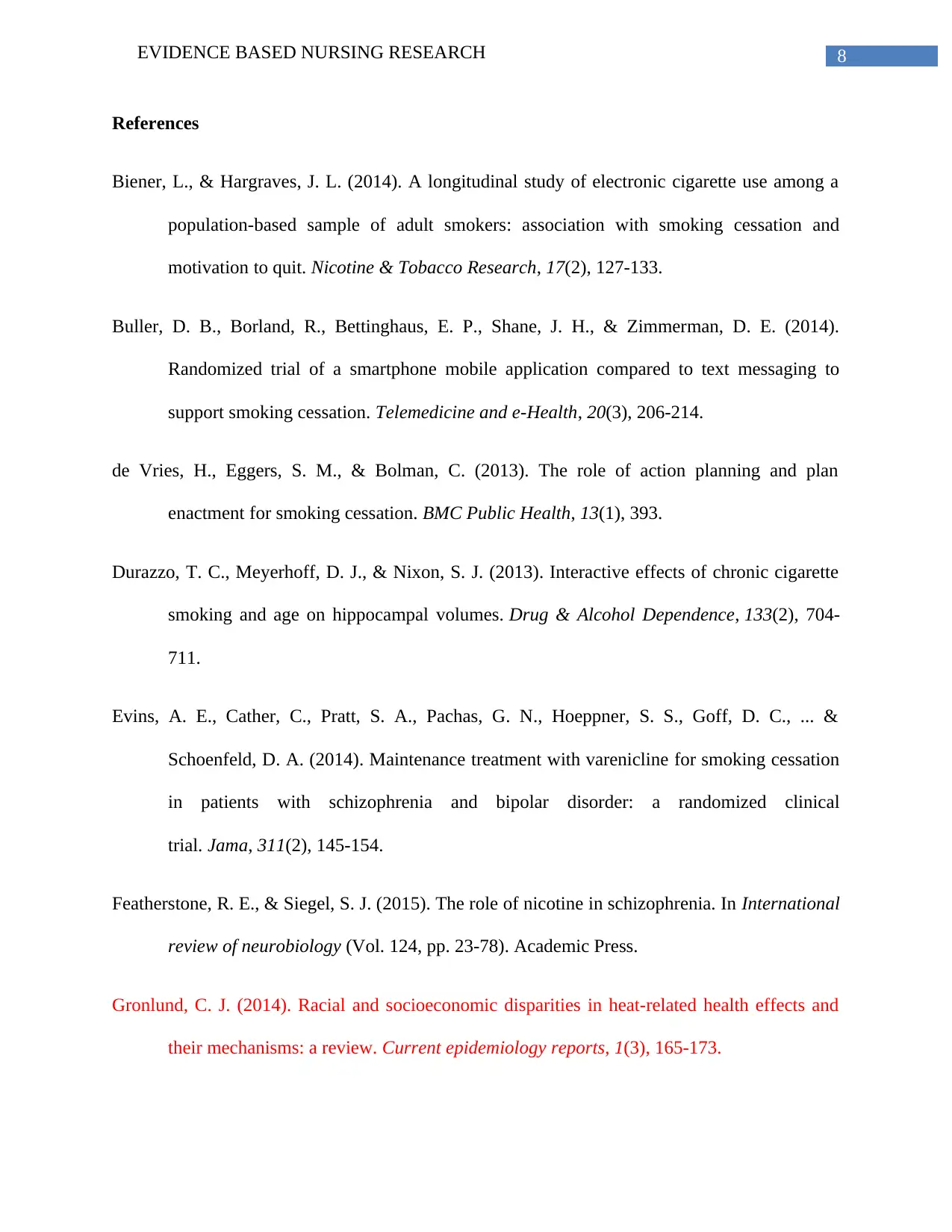
8EVIDENCE BASED NURSING RESEARCH
References
Biener, L., & Hargraves, J. L. (2014). A longitudinal study of electronic cigarette use among a
population-based sample of adult smokers: association with smoking cessation and
motivation to quit. Nicotine & Tobacco Research, 17(2), 127-133.
Buller, D. B., Borland, R., Bettinghaus, E. P., Shane, J. H., & Zimmerman, D. E. (2014).
Randomized trial of a smartphone mobile application compared to text messaging to
support smoking cessation. Telemedicine and e-Health, 20(3), 206-214.
de Vries, H., Eggers, S. M., & Bolman, C. (2013). The role of action planning and plan
enactment for smoking cessation. BMC Public Health, 13(1), 393.
Durazzo, T. C., Meyerhoff, D. J., & Nixon, S. J. (2013). Interactive effects of chronic cigarette
smoking and age on hippocampal volumes. Drug & Alcohol Dependence, 133(2), 704-
711.
Evins, A. E., Cather, C., Pratt, S. A., Pachas, G. N., Hoeppner, S. S., Goff, D. C., ... &
Schoenfeld, D. A. (2014). Maintenance treatment with varenicline for smoking cessation
in patients with schizophrenia and bipolar disorder: a randomized clinical
trial. Jama, 311(2), 145-154.
Featherstone, R. E., & Siegel, S. J. (2015). The role of nicotine in schizophrenia. In International
review of neurobiology (Vol. 124, pp. 23-78). Academic Press.
Gronlund, C. J. (2014). Racial and socioeconomic disparities in heat-related health effects and
their mechanisms: a review. Current epidemiology reports, 1(3), 165-173.
References
Biener, L., & Hargraves, J. L. (2014). A longitudinal study of electronic cigarette use among a
population-based sample of adult smokers: association with smoking cessation and
motivation to quit. Nicotine & Tobacco Research, 17(2), 127-133.
Buller, D. B., Borland, R., Bettinghaus, E. P., Shane, J. H., & Zimmerman, D. E. (2014).
Randomized trial of a smartphone mobile application compared to text messaging to
support smoking cessation. Telemedicine and e-Health, 20(3), 206-214.
de Vries, H., Eggers, S. M., & Bolman, C. (2013). The role of action planning and plan
enactment for smoking cessation. BMC Public Health, 13(1), 393.
Durazzo, T. C., Meyerhoff, D. J., & Nixon, S. J. (2013). Interactive effects of chronic cigarette
smoking and age on hippocampal volumes. Drug & Alcohol Dependence, 133(2), 704-
711.
Evins, A. E., Cather, C., Pratt, S. A., Pachas, G. N., Hoeppner, S. S., Goff, D. C., ... &
Schoenfeld, D. A. (2014). Maintenance treatment with varenicline for smoking cessation
in patients with schizophrenia and bipolar disorder: a randomized clinical
trial. Jama, 311(2), 145-154.
Featherstone, R. E., & Siegel, S. J. (2015). The role of nicotine in schizophrenia. In International
review of neurobiology (Vol. 124, pp. 23-78). Academic Press.
Gronlund, C. J. (2014). Racial and socioeconomic disparities in heat-related health effects and
their mechanisms: a review. Current epidemiology reports, 1(3), 165-173.
⊘ This is a preview!⊘
Do you want full access?
Subscribe today to unlock all pages.

Trusted by 1+ million students worldwide
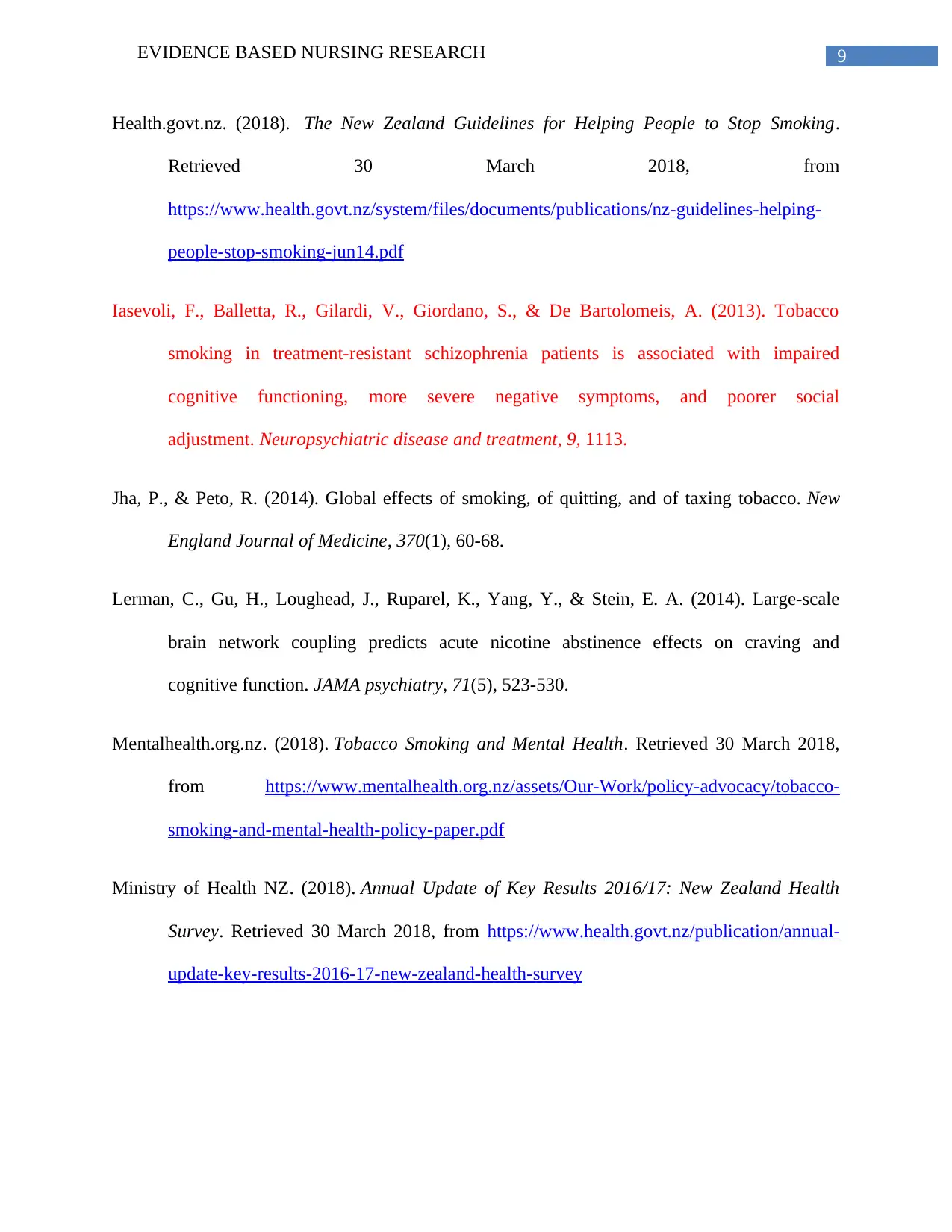
9EVIDENCE BASED NURSING RESEARCH
Health.govt.nz. (2018). The New Zealand Guidelines for Helping People to Stop Smoking.
Retrieved 30 March 2018, from
https://www.health.govt.nz/system/files/documents/publications/nz-guidelines-helping-
people-stop-smoking-jun14.pdf
Iasevoli, F., Balletta, R., Gilardi, V., Giordano, S., & De Bartolomeis, A. (2013). Tobacco
smoking in treatment-resistant schizophrenia patients is associated with impaired
cognitive functioning, more severe negative symptoms, and poorer social
adjustment. Neuropsychiatric disease and treatment, 9, 1113.
Jha, P., & Peto, R. (2014). Global effects of smoking, of quitting, and of taxing tobacco. New
England Journal of Medicine, 370(1), 60-68.
Lerman, C., Gu, H., Loughead, J., Ruparel, K., Yang, Y., & Stein, E. A. (2014). Large-scale
brain network coupling predicts acute nicotine abstinence effects on craving and
cognitive function. JAMA psychiatry, 71(5), 523-530.
Mentalhealth.org.nz. (2018). Tobacco Smoking and Mental Health. Retrieved 30 March 2018,
from https://www.mentalhealth.org.nz/assets/Our-Work/policy-advocacy/tobacco-
smoking-and-mental-health-policy-paper.pdf
Ministry of Health NZ. (2018). Annual Update of Key Results 2016/17: New Zealand Health
Survey. Retrieved 30 March 2018, from https://www.health.govt.nz/publication/annual-
update-key-results-2016-17-new-zealand-health-survey
Health.govt.nz. (2018). The New Zealand Guidelines for Helping People to Stop Smoking.
Retrieved 30 March 2018, from
https://www.health.govt.nz/system/files/documents/publications/nz-guidelines-helping-
people-stop-smoking-jun14.pdf
Iasevoli, F., Balletta, R., Gilardi, V., Giordano, S., & De Bartolomeis, A. (2013). Tobacco
smoking in treatment-resistant schizophrenia patients is associated with impaired
cognitive functioning, more severe negative symptoms, and poorer social
adjustment. Neuropsychiatric disease and treatment, 9, 1113.
Jha, P., & Peto, R. (2014). Global effects of smoking, of quitting, and of taxing tobacco. New
England Journal of Medicine, 370(1), 60-68.
Lerman, C., Gu, H., Loughead, J., Ruparel, K., Yang, Y., & Stein, E. A. (2014). Large-scale
brain network coupling predicts acute nicotine abstinence effects on craving and
cognitive function. JAMA psychiatry, 71(5), 523-530.
Mentalhealth.org.nz. (2018). Tobacco Smoking and Mental Health. Retrieved 30 March 2018,
from https://www.mentalhealth.org.nz/assets/Our-Work/policy-advocacy/tobacco-
smoking-and-mental-health-policy-paper.pdf
Ministry of Health NZ. (2018). Annual Update of Key Results 2016/17: New Zealand Health
Survey. Retrieved 30 March 2018, from https://www.health.govt.nz/publication/annual-
update-key-results-2016-17-new-zealand-health-survey
Paraphrase This Document
Need a fresh take? Get an instant paraphrase of this document with our AI Paraphraser
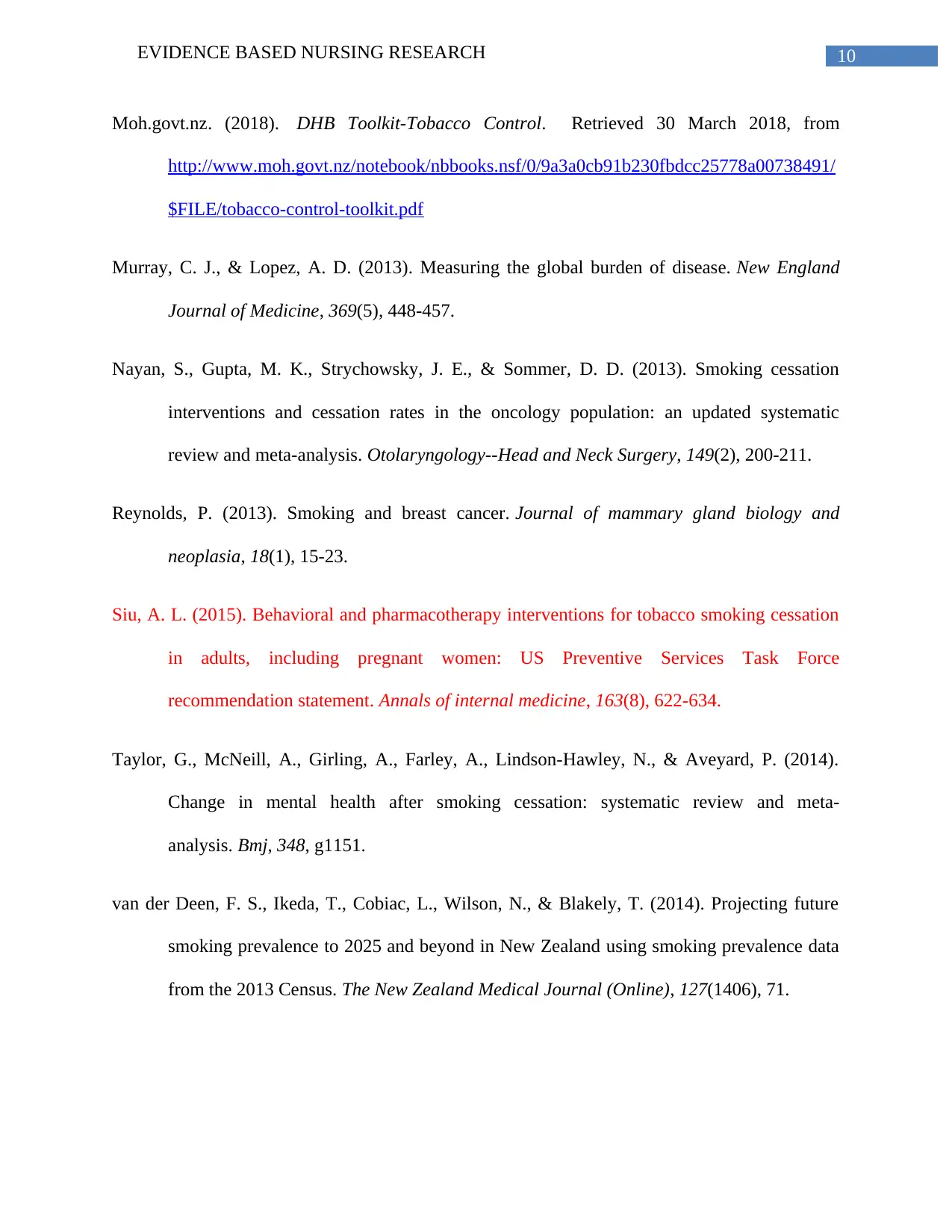
10EVIDENCE BASED NURSING RESEARCH
Moh.govt.nz. (2018). DHB Toolkit-Tobacco Control. Retrieved 30 March 2018, from
http://www.moh.govt.nz/notebook/nbbooks.nsf/0/9a3a0cb91b230fbdcc25778a00738491/
$FILE/tobacco-control-toolkit.pdf
Murray, C. J., & Lopez, A. D. (2013). Measuring the global burden of disease. New England
Journal of Medicine, 369(5), 448-457.
Nayan, S., Gupta, M. K., Strychowsky, J. E., & Sommer, D. D. (2013). Smoking cessation
interventions and cessation rates in the oncology population: an updated systematic
review and meta-analysis. Otolaryngology--Head and Neck Surgery, 149(2), 200-211.
Reynolds, P. (2013). Smoking and breast cancer. Journal of mammary gland biology and
neoplasia, 18(1), 15-23.
Siu, A. L. (2015). Behavioral and pharmacotherapy interventions for tobacco smoking cessation
in adults, including pregnant women: US Preventive Services Task Force
recommendation statement. Annals of internal medicine, 163(8), 622-634.
Taylor, G., McNeill, A., Girling, A., Farley, A., Lindson-Hawley, N., & Aveyard, P. (2014).
Change in mental health after smoking cessation: systematic review and meta-
analysis. Bmj, 348, g1151.
van der Deen, F. S., Ikeda, T., Cobiac, L., Wilson, N., & Blakely, T. (2014). Projecting future
smoking prevalence to 2025 and beyond in New Zealand using smoking prevalence data
from the 2013 Census. The New Zealand Medical Journal (Online), 127(1406), 71.
Moh.govt.nz. (2018). DHB Toolkit-Tobacco Control. Retrieved 30 March 2018, from
http://www.moh.govt.nz/notebook/nbbooks.nsf/0/9a3a0cb91b230fbdcc25778a00738491/
$FILE/tobacco-control-toolkit.pdf
Murray, C. J., & Lopez, A. D. (2013). Measuring the global burden of disease. New England
Journal of Medicine, 369(5), 448-457.
Nayan, S., Gupta, M. K., Strychowsky, J. E., & Sommer, D. D. (2013). Smoking cessation
interventions and cessation rates in the oncology population: an updated systematic
review and meta-analysis. Otolaryngology--Head and Neck Surgery, 149(2), 200-211.
Reynolds, P. (2013). Smoking and breast cancer. Journal of mammary gland biology and
neoplasia, 18(1), 15-23.
Siu, A. L. (2015). Behavioral and pharmacotherapy interventions for tobacco smoking cessation
in adults, including pregnant women: US Preventive Services Task Force
recommendation statement. Annals of internal medicine, 163(8), 622-634.
Taylor, G., McNeill, A., Girling, A., Farley, A., Lindson-Hawley, N., & Aveyard, P. (2014).
Change in mental health after smoking cessation: systematic review and meta-
analysis. Bmj, 348, g1151.
van der Deen, F. S., Ikeda, T., Cobiac, L., Wilson, N., & Blakely, T. (2014). Projecting future
smoking prevalence to 2025 and beyond in New Zealand using smoking prevalence data
from the 2013 Census. The New Zealand Medical Journal (Online), 127(1406), 71.

11EVIDENCE BASED NURSING RESEARCH
Waterhouse, U., Roper, V. E., Brennan, K. A., & Ellenbroek, B. A. (2016). Nicotine ameliorates
schizophrenia-like cognitive deficits induced by maternal LPS exposure: a study in
rats. Disease models & mechanisms, 9(10), 1159-1167.
Zwar, N. A., Mendelsohn, C. P., & Richmond, R. L. (2014). Supporting smoking
cessation. BMJ, 348, f7535.
Waterhouse, U., Roper, V. E., Brennan, K. A., & Ellenbroek, B. A. (2016). Nicotine ameliorates
schizophrenia-like cognitive deficits induced by maternal LPS exposure: a study in
rats. Disease models & mechanisms, 9(10), 1159-1167.
Zwar, N. A., Mendelsohn, C. P., & Richmond, R. L. (2014). Supporting smoking
cessation. BMJ, 348, f7535.
⊘ This is a preview!⊘
Do you want full access?
Subscribe today to unlock all pages.

Trusted by 1+ million students worldwide
1 out of 12
Related Documents
Your All-in-One AI-Powered Toolkit for Academic Success.
+13062052269
info@desklib.com
Available 24*7 on WhatsApp / Email
![[object Object]](/_next/static/media/star-bottom.7253800d.svg)
Unlock your academic potential
Copyright © 2020–2025 A2Z Services. All Rights Reserved. Developed and managed by ZUCOL.





